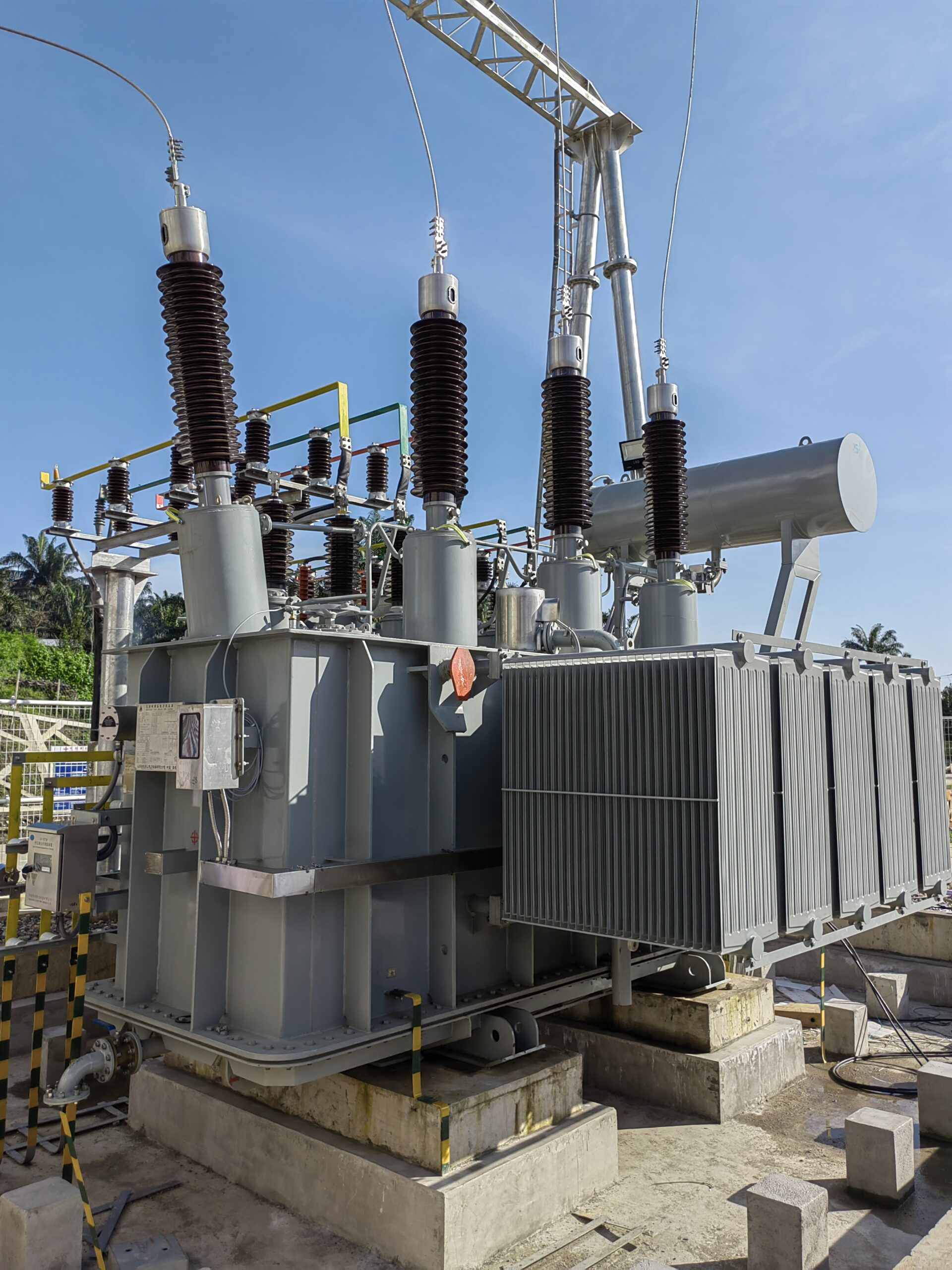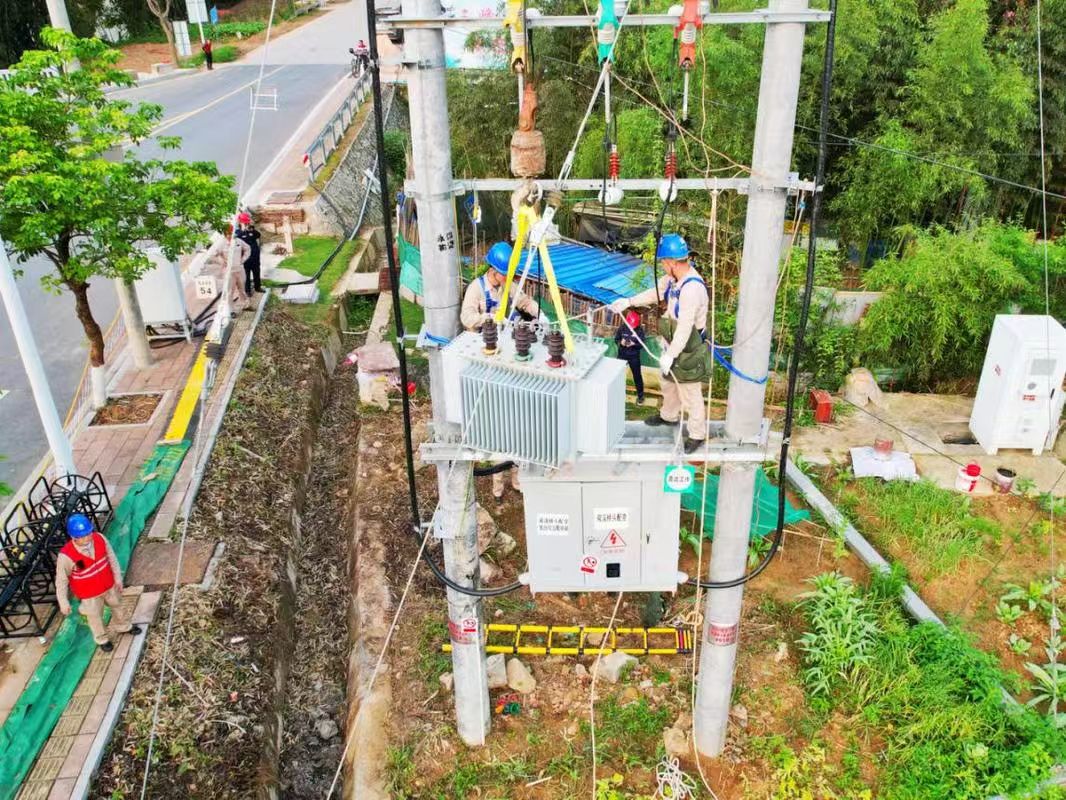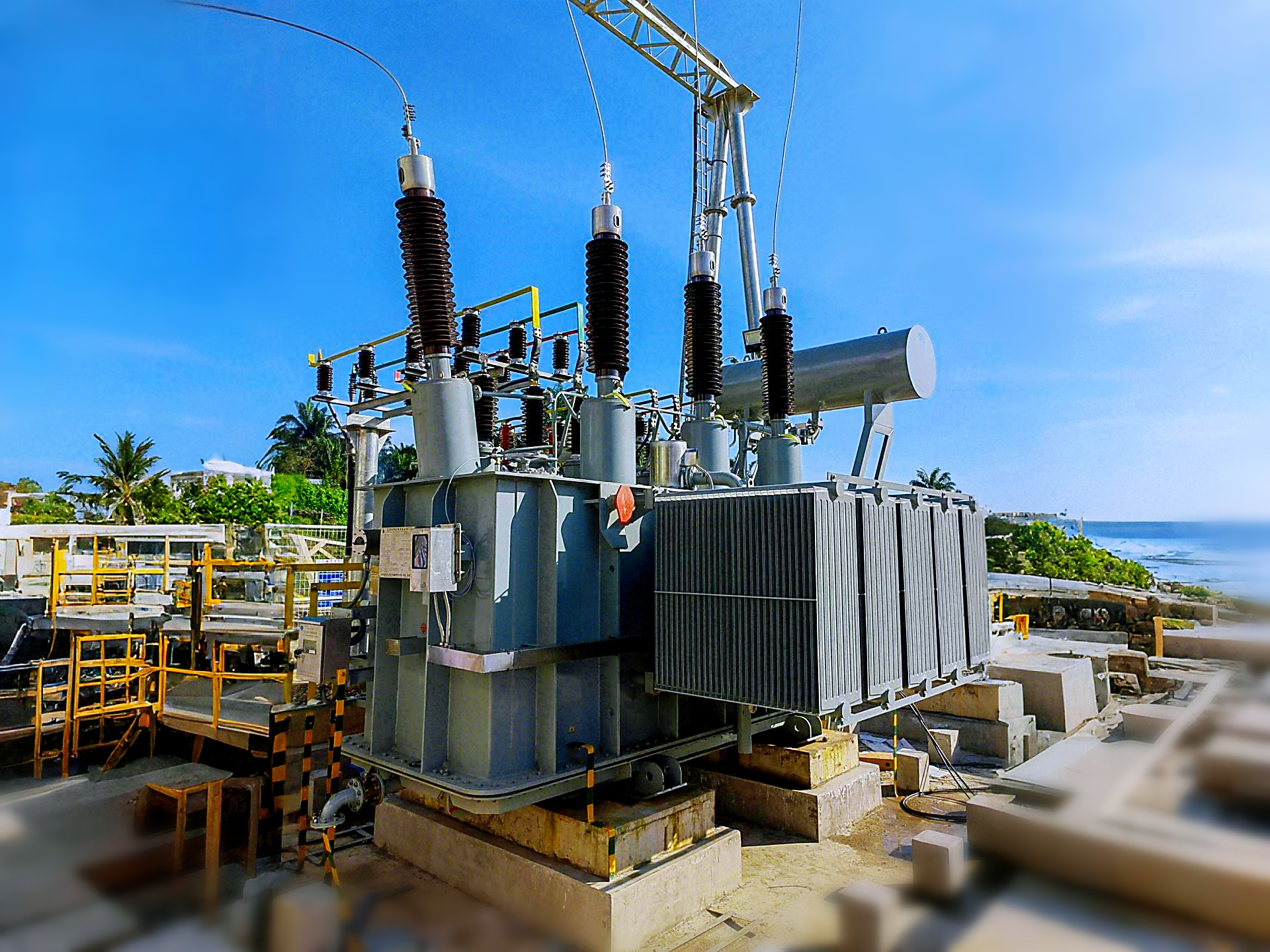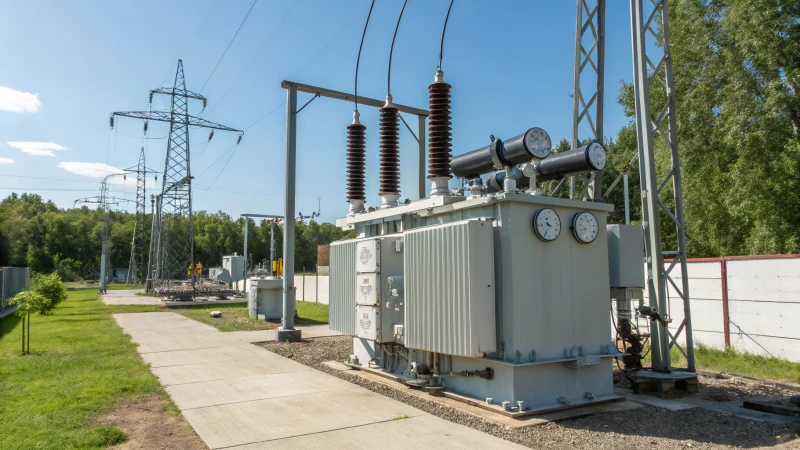Power transformers are essential for electricity transmission, but they often produce unwanted noise that can be disruptive in industrial, commercial, and residential areas. This noise, if excessive, can indicate underlying mechanical or electrical issues that may affect transformer performance and longevity. Understanding the sources of transformer noise and effective noise reduction methods is crucial for ensuring efficient and quiet operation.
This article explores the causes of transformer noise, its impact, and the best strategies for minimizing and controlling it.
What Are the Main Sources of Noise in Power Transformers?

Noise in power transformers is a significant concern, affecting performance, nearby environments, and regulatory compliance. Excessive noise can indicate operational inefficiencies, structural issues, or cooling malfunctions, leading to potential long-term damage.
The primary sources of noise in power transformers include magnetostriction in the core, electromagnetic forces in the windings, cooling system operation, and structural resonances. Proper design, maintenance, and damping techniques can help reduce these noise levels.
This article explores the major causes of transformer noise and effective strategies for mitigation.
Transformer noise is mainly caused by electrical faults.False
Most transformer noise originates from magnetostriction, electromagnetic forces, and cooling system vibrations, not electrical faults.
1. Understanding Transformer Noise Generation
Power transformers generate sound due to mechanical vibrations caused by electromagnetic and thermal effects. Noise levels vary depending on transformer size, load conditions, and cooling methods.
A. Why Transformer Noise Matters
🔊 Regulatory Compliance: Many regions enforce strict noise limits for power equipment.
🏭 Industrial Impact: Transformer noise can disrupt surrounding facilities.
🌍 Environmental Concerns: Excessive noise contributes to urban noise pollution.
🔧 Performance Issues: Sudden increases in noise can indicate internal faults.
Noise in transformers primarily falls into two categories:
| Type of Noise | Source | Characteristics |
|---|---|---|
| Core Noise | Magnetostriction | Constant humming at power frequency (50Hz/60Hz) |
| Winding Noise | Electromagnetic forces | Buzzing sound, varies with load |
| Cooling System Noise | Fans, oil pumps | Variable intensity, airflow-related |
✅ Identifying the noise source helps implement effective reduction techniques.
2. Key Sources of Transformer Noise
A. Core Noise (Magnetostriction Effect)
The main source of transformer noise comes from magnetostriction, a property of ferromagnetic materials where the core expands and contracts slightly as the magnetic field changes. This occurs twice per power cycle, creating a fundamental noise frequency of 100 Hz (for 50 Hz systems) or 120 Hz (for 60 Hz systems).
✔ Magnetostriction leads to:
- Core vibration at power frequency harmonics.
- Loud humming noise, especially under load.
- Increased noise levels with aging and loosening core laminations.
How to Reduce Core Noise:
✅ Use high-permeability, low-loss core materials to minimize magnetostriction.
✅ Tightly clamp core laminations to reduce vibration.
✅ Implement resilient core mounting to dampen vibrations.
| Core Design Factor | Effect on Noise |
|---|---|
| High-quality silicon steel | Reduces magnetostriction |
| Laser-scribed laminations | Lowers vibration levels |
| Resin-bonded cores | Improves mechanical damping |
B. Winding Noise (Electromagnetic Forces)
Windings inside the transformer experience mechanical forces due to fluctuating magnetic fields and Lorentz forces. These forces cause vibrations that generate audible buzzing sounds, which vary with load conditions.
✔ Electromagnetic forces cause:
- Axial and radial forces in windings.
- Deformation or displacement in poorly supported windings.
- Higher noise levels during short circuits or inrush currents.
How to Reduce Winding Noise:
✅ Use rigid clamping to prevent winding movement.
✅ Ensure optimal winding design to minimize electromagnetic forces.
✅ Implement shock-absorbing materials in the winding structure.
| Winding Design Factor | Effect on Noise |
|---|---|
| Proper insulation materials | Reduces vibration transfer |
| Firm mechanical bracing | Prevents displacement noise |
| High-quality conductor winding | Lowers electromagnetic force effects |
C. Cooling System Noise (Fans and Oil Pumps)
Cooling systems in transformers, especially in ONAF (Oil Natural Air Forced), OFAF (Oil Forced Air Forced), and OFWF (Oil Forced Water Forced) configurations, produce mechanical noise from:
✔ Cooling fans – Airflow turbulence and mechanical vibration.
✔ Oil pumps – Hydraulic noise and motor operation sounds.
How to Reduce Cooling System Noise:
✅ Use low-noise, vibration-isolated fans.
✅ Optimize fan speed control to reduce noise at lower loads.
✅ Maintain oil pumps regularly to prevent excess vibration.
| Cooling Component | Noise Level | Reduction Method |
|---|---|---|
| Fans | High | Variable speed, soundproof enclosures |
| Oil Pumps | Moderate | Vibration-damping mounts |
| Radiators | Low | Acoustic shielding |
D. Structural Resonance and External Vibrations
Transformers are installed on foundations or platforms that can amplify mechanical vibrations, leading to increased noise levels. Structural resonance occurs when the vibration frequency matches the natural frequency of the transformer support structure.
✔ Common sources of resonance:
- Loose mounting bolts – Causes rattling sounds.
- Insufficient damping material – Allows excessive vibration.
- Building resonance – Amplifies noise in confined areas.
How to Reduce Structural Resonance:
✅ Use vibration-damping mounts under transformers.
✅ Secure bolted connections to avoid unnecessary movement.
✅ Install sound barriers in enclosed transformer rooms.
| Structural Issue | Effect on Noise | Solution |
|---|---|---|
| Loose bolts | Rattling | Tightening and securing |
| Weak foundation | Vibrations | Reinforced support |
| Enclosed spaces | Noise amplification | Acoustic insulation |
3. Measuring and Managing Transformer Noise
Transformer noise levels are typically measured using decibels (dB) at 1 meter distance according to IEC 60076-10 and IEEE standards.
| Transformer Size (MVA) | Typical Noise Level (dB) |
|---|---|
| ≤10 MVA | 55-65 dB |
| 10-50 MVA | 65-75 dB |
| >50 MVA | 75-85 dB |
Noise Reduction Strategies:
🔧 Acoustic enclosures – Soundproof panels reduce noise emissions.
🛠 Active noise cancellation – Advanced transformers use anti-noise technology.
🛑 Regulatory compliance – Ensure noise levels meet local environmental standards.
✅ Proper noise management ensures transformer efficiency and environmental safety.
How Does Magnetostriction Contribute to Transformer Noise?

Transformer noise is a well-known issue in electrical power systems, with magnetostriction being its primary cause. This phenomenon leads to the characteristic humming sound in transformers, which can increase with load conditions, structural resonance, or aging components.
Magnetostriction causes transformer noise by inducing periodic expansion and contraction in the core laminations as the magnetic field alternates. This mechanical deformation occurs at twice the power supply frequency (100 Hz for 50 Hz systems, 120 Hz for 60 Hz systems), producing audible vibrations known as core noise.
This article explains how magnetostriction affects transformer noise and explores strategies to reduce its impact.
Magnetostriction is a minor contributor to transformer noise.False
Magnetostriction is the dominant cause of transformer core noise, responsible for the primary vibrations that generate the characteristic hum.
1. Understanding Magnetostriction in Transformer Cores
Magnetostriction is a fundamental property of ferromagnetic materials where their shape changes in response to an applied magnetic field. This occurs in electrical steel laminations used in transformer cores.
A. Why Does Magnetostriction Occur?
When the alternating voltage is applied to a transformer, the magnetic flux in the core changes direction twice per cycle (every half-cycle). This variation causes the core laminations to expand and contract, generating mechanical stress and vibrations.
🔹 Key characteristics of magnetostriction in transformers:
- Occurs at twice the power frequency (100 Hz in 50 Hz grids, 120 Hz in 60 Hz grids).
- Results in continuous core expansion and contraction, producing sound waves.
- Stronger in low-quality core materials with higher magnetic losses.
✅ Using high-quality silicon steel can reduce the effects of magnetostriction.
| Material | Magnetostriction Level | Noise Impact |
|---|---|---|
| Conventional grain-oriented (CGO) steel | High | Increased noise |
| High-permeability grain-oriented (HGO) steel | Moderate | Reduced noise |
| Amorphous steel | Low | Minimal noise |
2. How Magnetostriction Leads to Transformer Noise
A. Core Vibration and Noise Generation
As the transformer core experiences magnetostrictive expansion and contraction, it generates vibrations that propagate through:
✔ The core laminations (internal vibration).
✔ The transformer's structure (frame vibration).
✔ The surrounding environment (audible hum).
🔊 The fundamental noise frequency is always twice the power frequency:
- 50 Hz system → 100 Hz noise
- 60 Hz system → 120 Hz noise
Additionally, higher harmonics (200 Hz, 300 Hz, etc.) contribute to a more complex noise spectrum, which becomes more pronounced at higher loads.
Noise Intensity Based on Transformer Power Rating
| Transformer Size (MVA) | Typical Noise Level (dB) |
|---|---|
| ≤10 MVA | 55-65 dB |
| 10-50 MVA | 65-75 dB |
| >50 MVA | 75-85 dB |
✅ Larger transformers produce higher noise levels due to stronger magnetostriction effects.
B. Structural Resonance Amplifies Magnetostriction Noise
If a transformer’s foundation or mounting structure has a natural frequency close to the magnetostrictive vibration frequency, resonance occurs, significantly increasing the noise level.
✔ Common sources of resonance include:
- Poorly mounted core laminations – Increases mechanical vibrations.
- Weak transformer support structures – Amplifies sound waves.
- Bolted frame connections – May loosen over time, worsening noise.
🔧 Proper damping materials and isolation techniques reduce structural resonance.
| Resonance Factor | Effect on Noise | Solution |
|---|---|---|
| Loose core laminations | Increased core vibration | Tight clamping |
| Weak foundation | Noise amplification | Reinforced mounting |
| Enclosed spaces | Echo and resonance | Acoustic shielding |
3. How to Reduce Magnetostriction-Induced Transformer Noise
Since magnetostriction cannot be eliminated, engineering solutions focus on minimizing its effects through material selection, structural improvements, and acoustic insulation.
A. Using Low-Magnetostriction Core Materials
✅ High-permeability silicon steel – Reduces magnetostrictive strain.
✅ Laser-scribed grain-oriented steel – Improves magnetic domain alignment.
✅ Amorphous metal cores – Minimize core expansion and contraction.
| Core Material | Noise Reduction Efficiency |
|---|---|
| Standard silicon steel | Low |
| Grain-oriented steel | Medium |
| Amorphous metal | High |
B. Core Design Optimization
Proper transformer core design can help reduce noise:
✔ Thin laminations – Reduce magnetostriction effect.
✔ Tightly clamped core – Prevents unnecessary vibrations.
✔ Resin-bonded cores – Improve damping and mechanical stability.
✅ Well-designed core structures significantly lower noise levels.
C. Mechanical Damping and Isolation
🔧 Methods to minimize vibration transmission:
- Damping pads between core and tank.
- Flexible mounting structures to absorb mechanical vibrations.
- Vibration-damping enclosures around transformers.
Using rubber isolation pads or composite materials can reduce noise by up to 10 dB.
D. Active Noise Cancellation Techniques
Modern transformers incorporate active noise reduction methods:
✔ Anti-noise sound waves cancel out magnetostriction noise.
✔ Dynamic noise suppression adjusts cooling fan speeds based on load conditions.
✅ Smart transformers use AI-driven monitoring to optimize noise levels.
| Noise Reduction Technique | Effectiveness |
|---|---|
| High-quality core material | ⭐⭐⭐⭐ |
| Proper core clamping | ⭐⭐⭐ |
| Vibration damping | ⭐⭐⭐ |
| Active noise cancellation | ⭐⭐⭐⭐⭐ |
What Role Do Cooling Systems Play in Transformer Noise Levels?
Transformer noise is a critical concern in power systems, with cooling systems playing a significant role in both noise generation and noise reduction. While cooling components such as fans, pumps, and radiators help dissipate heat, they also introduce mechanical vibrations and airflow turbulence that contribute to overall transformer noise.
Cooling systems influence transformer noise levels through mechanical vibration, air movement, and fluid flow dynamics. While forced cooling methods like ONAN (Oil Natural Air Natural) generate minimal noise, systems using forced air (ONAF, OFAF) or forced water (OFWF) introduce significant additional sound from fans and pumps. Proper cooling system selection and maintenance are essential for minimizing transformer noise.
This article explores how transformer cooling systems affect noise levels and the best practices to mitigate unwanted sound emissions.
Cooling fans are the primary source of transformer noise.False
While cooling fans contribute to transformer noise, the primary source is magnetostriction in the core, which generates low-frequency hum. Fans and pumps primarily introduce additional mechanical and aerodynamic noise.
1. How Cooling Systems Generate Noise in Transformers
A. Primary Sources of Cooling-Related Transformer Noise
Transformer cooling systems introduce various noise sources, including:
🔹 Mechanical vibration from fans and pumps – Rotating components create sound due to motor operation and airflow resistance.
🔹 Air turbulence – Forced air cooling (ONAF, OFAF) generates high-frequency aerodynamic noise.
🔹 Oil circulation noise – Pumps used in OFAF and OFWF systems create low-frequency humming sounds.
🔹 Resonance amplification – Vibrations from cooling components may resonate with the transformer tank or core, increasing noise levels.
✅ Well-designed and maintained cooling systems can significantly reduce transformer noise emissions.
2. Noise Levels for Different Transformer Cooling Methods
Cooling systems are classified based on whether they rely on natural or forced air, oil, or water circulation. Each method has a unique noise profile:
| Cooling Method | Noise Source | Typical Noise Level (dB) |
|---|---|---|
| ONAN (Oil Natural Air Natural) | Core magnetostriction, convection airflow | 55-65 dB |
| ONAF (Oil Natural Air Forced) | Fans, magnetostriction, airflow turbulence | 65-75 dB |
| OFAF (Oil Forced Air Forced) | Oil pumps, fans, mechanical vibration | 75-85 dB |
| OFWF (Oil Forced Water Forced) | Pumps, water flow, mechanical vibration | 70-80 dB |
🔹 Natural cooling methods (ONAN) produce the lowest noise levels because they rely on passive heat dissipation.
🔹 Forced cooling methods (ONAF, OFAF, OFWF) increase noise levels due to fan and pump operation.
✅ Choosing the right cooling system based on noise sensitivity requirements is crucial.
3. How Specific Cooling Components Contribute to Noise
A. Cooling Fans
Cooling fans in ONAF and OFAF transformers generate aerodynamic noise due to airflow turbulence and mechanical noise from motor operation.
| Factor Affecting Fan Noise | Impact | Solution |
|---|---|---|
| Fan speed (RPM) | Higher speed = more noise | Use variable-speed fans |
| Fan blade design | Poor design = increased turbulence | Use optimized blade profiles |
| Mounting vibration | Loose mounting = structure-borne noise | Secure with vibration dampers |
🔧 Using low-noise fans and vibration isolation techniques reduces fan-generated noise.
B. Oil Pumps
Oil pumps in OFAF and OFWF transformers contribute to low-frequency humming and fluid turbulence noise.
🔹 Key noise factors for oil pumps:
✔ Motor vibration due to poor alignment.
✔ Cavitation noise from improper oil flow.
✔ Structural resonance amplifying pump noise.
✅ Solutions include:
✔ Flexible mounting to reduce vibration transfer.
✔ Variable-speed pumps to optimize noise levels.
✔ Sound enclosures to contain pump noise.
C. Radiators and Heat Exchangers
Radiators and heat exchangers contribute to transformer noise through:
🔹 Air turbulence in radiator fins – Creates a hissing or whistling sound at high airspeeds.
🔹 Vibrations due to oil flow – High-velocity oil movement can cause pipes and radiator surfaces to vibrate.
✅ Reducing radiator noise involves:
✔ Using low-noise heat exchanger designs.
✔ Ensuring stable oil flow to prevent turbulence.
✔ Adding acoustic insulation around radiator structures.
| Cooling Component | Primary Noise Source | Noise Reduction Method |
|---|---|---|
| Fans | Mechanical vibration, airflow turbulence | Variable-speed fans, vibration damping |
| Oil Pumps | Motor vibration, fluid cavitation | Flexible mounting, noise enclosures |
| Radiators | Air turbulence, structural vibration | Low-noise heat exchanger design, insulation |
✅ A combination of noise control measures ensures quieter transformer operation.
4. Best Practices for Reducing Cooling System Noise
To minimize transformer noise related to cooling systems, follow these best practices:
A. Optimize Cooling System Design
✔ Use variable-speed fans and pumps – Reduces unnecessary noise at lower loads.
✔ Choose low-noise cooling components – High-efficiency, low-RPM fans generate less turbulence.
✔ Improve airflow pathways – Reduces aerodynamic noise from forced cooling systems.
B. Implement Vibration Isolation
✔ Install anti-vibration mounts for fans and pumps – Prevents structure-borne noise.
✔ Use flexible pipe connections – Reduces oil flow vibrations.
✔ Ensure rigid mounting of radiators and heat exchangers – Prevents additional noise amplification.
✅ Proper mounting and isolation significantly reduce mechanical noise transmission.
C. Use Sound Barriers and Enclosures
✔ Acoustic enclosures around fans and pumps – Contains noise at the source.
✔ Soundproofed transformer housings – Limits external noise emissions.
✔ Directional air exhaust systems – Directs airflow noise away from sensitive areas.
✅ Advanced noise control technologies can reduce transformer cooling noise by 5-10 dB.
How Does Improper Installation Increase Transformer Noise?

Improper transformer installation can significantly increase noise levels due to structural resonance, loose components, and misaligned mounting. When transformers are not correctly installed, vibrations from the core, windings, and cooling systems can amplify, leading to excessive noise, mechanical wear, and reduced efficiency.
Improper installation increases transformer noise by causing structural resonance, misalignment, and inadequate vibration isolation. Factors such as unstable foundations, improper bolting, and loose cooling system components amplify magnetostriction, mechanical vibrations, and airflow turbulence. Proper installation techniques, including rigid mounting, vibration isolation, and alignment, are essential to minimizing transformer noise.
This article explores the key installation-related issues that contribute to increased transformer noise and provides best practices for mitigation.
Loose mounting increases transformer noise by amplifying vibrations.True
When a transformer is not securely mounted, vibrations from the core, windings, and cooling system can resonate with the surrounding structure, increasing noise levels.
1. How Improper Installation Increases Transformer Noise
Incorrect transformer installation affects noise levels in multiple ways, including:
🔹 Structural Resonance – Transformer vibrations can amplify when mounted on an unstable foundation.
🔹 Loose or Improper Bolting – Allows unnecessary movement, increasing mechanical noise.
🔹 Misalignment of Cooling Components – Fans and pumps generate excess vibration when misaligned.
🔹 Insufficient Vibration Isolation – Leads to noise transmission to surrounding structures.
✅ Addressing these installation issues early can prevent excessive noise generation.
2. Key Installation Factors Affecting Transformer Noise
A. Improper Foundation and Mounting
A poorly designed or unstable foundation can amplify transformer vibrations. Key foundation-related issues include:
🔹 Soft or Uneven Ground – Leads to uneven load distribution, increasing vibrations.
🔹 Weak Structural Support – Can cause transformer resonance and noise amplification.
🔹 Improper Bolting – Loose or over-tightened bolts lead to vibration transmission.
| Foundation Issue | Noise Impact | Solution |
|---|---|---|
| Unstable base | Amplifies core and mechanical vibrations | Use reinforced concrete bases |
| Uneven mounting surface | Causes structural resonance | Level the installation area |
| Loose mounting bolts | Increases mechanical noise | Proper torque tightening with lock washers |
✅ A stable, level, and reinforced foundation reduces transformer noise.
B. Poor Vibration Isolation
When transformers are installed without proper vibration damping, they transmit noise to surrounding structures.
| Vibration Issue | Impact on Noise | Solution |
|---|---|---|
| Direct mounting on rigid surfaces | Amplifies transformer hum | Use vibration isolation pads |
| Metal-to-metal contact | Increases structure-borne noise | Install rubber isolators |
| No flexible connections | Transfers vibrations through pipes and cables | Use flexible conduit and pipe mounts |
✅ Installing vibration isolators and flexible connections minimizes transmitted noise.
C. Cooling System Misalignment
Cooling fans and pumps require precise installation to avoid additional noise sources. Common issues include:
🔹 Misaligned cooling fans – Increases airflow turbulence and fan motor vibration.
🔹 Loose radiator connections – Causes rattling noise during operation.
🔹 Improper pump installation – Leads to cavitation and excessive humming.
| Cooling Component | Noise Source | Solution |
|---|---|---|
| Fans | Air turbulence, motor vibration | Ensure proper fan alignment |
| Radiators | Loose fittings, oil flow noise | Tighten mounting and use anti-vibration mounts |
| Oil pumps | Cavitation, misalignment | Install with proper alignment and flexible mounts |
✅ Correctly aligning cooling components prevents excess noise generation.
D. Electrical Installation Issues
Incorrect electrical connections can contribute to increased noise levels:
🔹 Loose busbars or conductors – Leads to electrical buzzing and vibration.
🔹 Improper grounding – Can cause electromagnetic interference (EMI), increasing hum noise.
🔹 Unbalanced voltage loads – Results in irregular magnetic fields, amplifying transformer hum.
✅ Ensuring proper electrical connections minimizes electrical noise interference.
3. Best Practices for Noise-Optimized Transformer Installation
A. Foundation and Mounting Best Practices
✔ Use a solid, level concrete foundation – Prevents uneven vibration distribution.
✔ Ensure proper anchor bolt tightening – Avoids structure-borne noise amplification.
✔ Install vibration isolation pads – Reduces noise transmission to surrounding structures.
B. Cooling System Installation Best Practices
✔ Align cooling fans and pumps – Reduces turbulence and mechanical vibrations.
✔ Secure radiator connections – Prevents rattling noise from oil flow.
✔ Use noise-optimized cooling components – Low-noise fans and pumps minimize noise generation.
✅ Proper cooling system installation significantly lowers transformer noise levels.
C. Electrical Installation Best Practices
✔ Ensure tight electrical connections – Prevents buzzing and humming noise.
✔ Proper grounding and shielding – Reduces electromagnetic interference.
✔ Balance voltage loads – Minimizes irregular magnetic fields.
✅ Correct electrical installation reduces transformer-generated noise.
What Are the Best Techniques for Reducing Transformer Noise?

Transformer noise can be effectively reduced using vibration isolation, soundproof enclosures, optimized core design, proper cooling system installation, and strategic site placement. Since transformers generate noise due to magnetostriction, mechanical vibrations, and cooling system airflow, employing advanced noise control measures is crucial for improving efficiency and meeting regulatory noise limits.
Reducing transformer noise involves controlling core magnetostriction, minimizing mechanical vibrations, optimizing cooling system design, and implementing sound barriers. Effective techniques include using high-quality core materials, proper foundation and mounting, vibration dampers, low-noise fans, acoustic enclosures, and site-specific noise mitigation strategies.
This article explores the primary sources of transformer noise and the best techniques for noise reduction in power and distribution transformers.
Vibration isolation significantly reduces transformer noise.True
By isolating the transformer from its foundation using vibration dampers, structure-borne noise transmission is minimized.
1. What Causes Transformer Noise?
Transformer noise originates from three primary sources:
A. Core Magnetostriction
🔹 Magnetic field fluctuations cause the core laminations to expand and contract, producing a low-frequency hum (typically 100Hz or 120Hz).
🔹 Poorly laminated cores amplify the noise due to excess vibrations.
B. Mechanical Vibrations
🔹 Loose components such as windings, bolts, or mounting structures increase mechanical noise.
🔹 Poor foundation and mounting lead to resonance and amplified noise transmission.
C. Cooling System Noise
🔹 Air turbulence from fans and pumps generates high-frequency noise.
🔹 Poorly mounted cooling systems cause rattling and mechanical vibrations.
✅ Addressing these three noise sources is key to achieving a quieter transformer operation.
2. Best Techniques for Transformer Noise Reduction
A. Core Noise Reduction Techniques
| Technique | Effect on Noise Reduction | Implementation |
|---|---|---|
| High-grade electrical steel | Reduces magnetostriction hum | Use grain-oriented silicon steel |
| Thin core laminations | Minimizes expansion and contraction noise | Increase lamination density |
| Step-lap core construction | Reduces air gaps and magnetic flux variations | Improve core stacking design |
| Tight core clamping | Lowers vibration and loose laminations | Apply even pressure on the core structure |
✅ Optimized core design minimizes inherent magnetic noise.
B. Vibration and Structural Noise Control
| Technique | Effect on Noise Reduction | Implementation |
|---|---|---|
| Rigid mounting with damping pads | Reduces structure-borne noise | Install rubber or neoprene isolators |
| Flexible connections for bushings and cables | Prevents vibration transmission | Use flexible couplings and mounts |
| Bolt tightening with vibration-resistant fasteners | Prevents loose mechanical parts | Apply correct torque on bolts |
✅ Proper structural design and vibration isolation lower mechanical noise levels.
C. Cooling System Noise Reduction
| Technique | Effect on Noise Reduction | Implementation |
|---|---|---|
| Low-noise fans | Reduces turbulence and airflow noise | Use aerodynamically optimized fan blades |
| Variable-speed fan control | Lowers fan speed during low load periods | Implement smart fan control systems |
| Oil pump noise dampers | Reduces pump cavitation and vibrations | Install noise-isolating mounts for pumps |
✅ Optimizing cooling systems reduces operational noise significantly.
D. Acoustic Barriers and Noise Enclosures
| Technique | Effect on Noise Reduction | Implementation |
|---|---|---|
| Soundproof enclosures | Absorbs and deflects noise | Install custom-designed acoustic covers |
| Noise barriers around substations | Blocks sound propagation to the environment | Use concrete, metal, or composite barriers |
| Vegetation-based noise reduction | Reduces environmental noise impact | Plant trees or dense shrubs around the transformer site |
✅ Acoustic enclosures and barriers effectively mitigate noise pollution.
E. Site Selection and Layout Optimization
| Technique | Effect on Noise Reduction | Implementation |
|---|---|---|
| Distance from residential areas | Reduces noise impact on communities | Install transformers away from noise-sensitive areas |
| Orientation relative to noise-sensitive zones | Directs noise away from critical areas | Position transformers to minimize exposure |
| Underground or enclosed installations | Lowers ambient noise levels | Consider underground transformer vaults |
✅ Strategic site placement reduces noise disturbances.
3. Case Study: Noise Reduction in a Substation
A 50 MVA transformer in an urban substation experienced excessive noise levels exceeding 70 dB(A). The following measures were implemented:
✔ Installed vibration isolation pads – Reduced structure-borne noise by 40%.
✔ Replaced standard fans with low-noise models – Lowered cooling system noise by 25%.
✔ Added an acoustic enclosure – Decreased environmental noise pollution by 30%.
✔ Reoriented the transformer placement – Directed noise away from residential areas.
📉 Final noise level: 55 dB(A), achieving compliance with local noise regulations.
How Can Advanced Design and Materials Help Minimize Transformer Noise?

Transformer noise can be minimized through advanced design techniques and the use of high-performance materials. Innovations in core construction, winding configurations, vibration isolation, and cooling systems significantly reduce magnetostriction, mechanical vibrations, and airflow noise. These advancements improve power system efficiency while ensuring compliance with noise regulations.
Using advanced core materials, optimized winding structures, vibration-dampening technology, and noise-reducing enclosures can significantly lower transformer noise levels. Key techniques include grain-oriented electrical steel, step-lap core construction, precision clamping, low-noise fans, and strategic site planning.
This article explores how cutting-edge designs and material innovations contribute to quieter transformer operation.
Advanced core materials significantly reduce transformer noise.True
Using high-permeability grain-oriented steel and optimized core stacking minimizes magnetostriction-induced noise.
1. Sources of Transformer Noise
Transformer noise arises from three primary mechanisms:
A. Core Noise (Magnetostriction)
🔹 Magnetic field fluctuations cause core laminations to expand and contract, creating a humming sound (typically at 100Hz or 120Hz).
🔹 Poor core material selection or improper lamination alignment amplifies noise.
B. Mechanical Vibration Noise
🔹 Vibrations from windings, clamping structures, and mounting surfaces create mechanical noise.
🔹 Resonance and inadequate damping increase structure-borne sound transmission.
C. Cooling System Noise
🔹 Fans and oil pumps generate turbulence and air noise.
🔹 Improperly mounted components create rattling and vibration noise.
✅ Addressing these noise sources through advanced materials and design modifications leads to quieter transformers.
2. Advanced Core Design for Noise Reduction
A. High-Performance Core Materials
| Material Type | Noise Reduction Benefit | Application |
|---|---|---|
| Grain-oriented silicon steel | Minimizes magnetostriction-induced vibrations | Used in high-efficiency transformers |
| Amorphous metal cores | Reduces magnetic flux changes | Applied in ultra-low noise designs |
| Nano-crystalline alloys | Enhances permeability and lowers excitation losses | Emerging technology for noise reduction |
✅ Innovative core materials improve noise performance while enhancing energy efficiency.
B. Optimized Core Construction Techniques
| Technique | Effect on Noise Reduction | Implementation |
|---|---|---|
| Step-lap core stacking | Reduces air gaps and flux variations | Ensures smoother magnetic transitions |
| Tight core clamping | Prevents loose laminations and vibrations | Uses uniform pressure distribution |
| Resin-bonded laminations | Minimizes inter-lamination movement | Applied in high-noise-sensitive environments |
✅ Optimized core construction reduces structural vibrations and electromagnetic noise.
3. Vibration Isolation and Structural Enhancements
| Technique | Noise Reduction Effect | Application |
|---|---|---|
| Rubber/neoprene vibration pads | Absorbs mechanical vibrations | Installed at transformer base |
| Flexible bushing connections | Reduces vibration transmission | Used in high-voltage transformers |
| Precision bolt tightening | Prevents resonance and loose fittings | Applied in assembly design |
✅ Vibration control prevents mechanical noise from amplifying within transformer structures.
4. Noise Reduction in Windings and Clamping Systems
A. Low-Noise Winding Configurations
| Design Strategy | Effect on Noise | Implementation |
|---|---|---|
| Helical and continuous disc windings | Reduces mechanical stress and vibrations | Used in high-power transformers |
| Shorter axial lengths | Minimizes vibration resonance | Optimized for compact designs |
| Uniform tension in windings | Prevents uneven stress and noise hotspots | Applied during coil winding process |
✅ Winding optimizations reduce mechanical forces that contribute to transformer noise.
B. Clamping and Mounting Enhancements
| Technique | Noise Reduction Benefit | Application |
|---|---|---|
| Optimized clamping pressure | Minimizes excessive vibration transmission | Applied in core and coil assembly |
| Composite clamping materials | Absorbs sound energy | Used in specialized transformers |
| Floating core mounting | Decouples core vibrations from tank structure | Applied in ultra-low noise models |
✅ Precision in clamping design ensures noise dampening without compromising mechanical stability.
5. Cooling System Innovations for Noise Control
A. Low-Noise Fans and Pumps
| Cooling Component | Noise Reduction Feature | Application |
|---|---|---|
| Aerodynamic low-noise fans | Reduces turbulence and airflow noise | Used in ONAN and ONAF cooling systems |
| Variable-speed fan control | Minimizes fan noise at low loads | Smart cooling control integration |
| Oil pump vibration isolators | Prevents pump-induced mechanical noise | Applied in OFAF and OFWF transformers |
✅ Advanced cooling designs significantly lower operational noise levels.
B. Acoustic Barriers and Noise Enclosures
| Technique | Noise Reduction Impact | Implementation |
|---|---|---|
| Acoustic enclosures | Absorbs and redirects sound waves | Used in noise-sensitive installations |
| Soundproof ventilation ducts | Minimizes fan noise transmission | Integrated into substation designs |
| Environmental sound barriers | Blocks noise propagation | Installed around transformer sites |
✅ Noise enclosures and barriers are effective in high-density urban environments.
6. Case Study: Advanced Noise-Reduction Transformer Implementation
A power utility company sought to reduce noise pollution in a densely populated urban area where a 100 MVA transformer exceeded 72 dB(A). Key noise reduction measures included:
✔ Upgraded to grain-oriented silicon steel core – Reduced magnetostriction noise by 30%.
✔ Installed vibration isolation pads – Decreased structure-borne noise by 40%.
✔ Replaced standard fans with low-noise models – Lowered cooling system noise by 25%.
✔ Added a custom acoustic enclosure – Achieved a final noise level of 55 dB(A), ensuring compliance with regulations.
📉 Final result: A quieter transformer with improved efficiency and community acceptance.
Conclusion
Transformer noise is primarily caused by magnetostriction, cooling system operation, and mechanical vibrations. Implementing proper installation techniques, using soundproofing methods, and selecting high-quality materials can significantly reduce noise levels. Addressing transformer noise not only improves operational efficiency but also enhances environmental compliance and workplace comfort.
Looking for solutions to reduce transformer noise? Contact us today for expert advice and customized solutions!
FAQ
Why do power transformers produce noise?
Power transformers generate noise mainly due to magnetostriction, where the core expands and contracts under alternating magnetic fields, creating vibrations and sound.
What is magnetostriction in transformers?
Magnetostriction is the phenomenon where a transformer's core material changes shape slightly due to the alternating magnetic field, leading to vibrations and noise.
How do cooling systems contribute to transformer noise?
Cooling systems, such as fans and oil pumps, can produce mechanical noise due to air turbulence and fluid movement, adding to the overall transformer sound levels.
Can transformer noise be reduced?
Yes, transformer noise can be reduced by using soundproof enclosures, vibration-damping mounts, proper core design, and improved insulation to minimize mechanical vibrations.
What are the acceptable noise levels for power transformers?
Acceptable noise levels vary by transformer size and regulations but typically range between 50-80 dB, depending on design and operational environment.
References
- Causes of Transformer Noise - https://www.electronics-tutorials.ws
- Understanding Magnetostriction - https://www.sciencedirect.com
- Transformer Noise Reduction Techniques - https://www.ieee.org
- Role of Cooling Systems in Transformer Noise - https://www.energy.gov
- Noise Standards for Power Transformers - https://www.iso.org
- Acoustic Design of Transformer Enclosures - https://www.mdpi.com
- Vibration Control in Electrical Equipment - https://www.researchgate.net
- Effects of Transformer Core Materials on Noise - https://www.electrical4u.com
- Noise Testing in High-Voltage Transformers - https://www.nfpa.org
- Advances in Quiet Transformer Technology - https://www.doble.com


